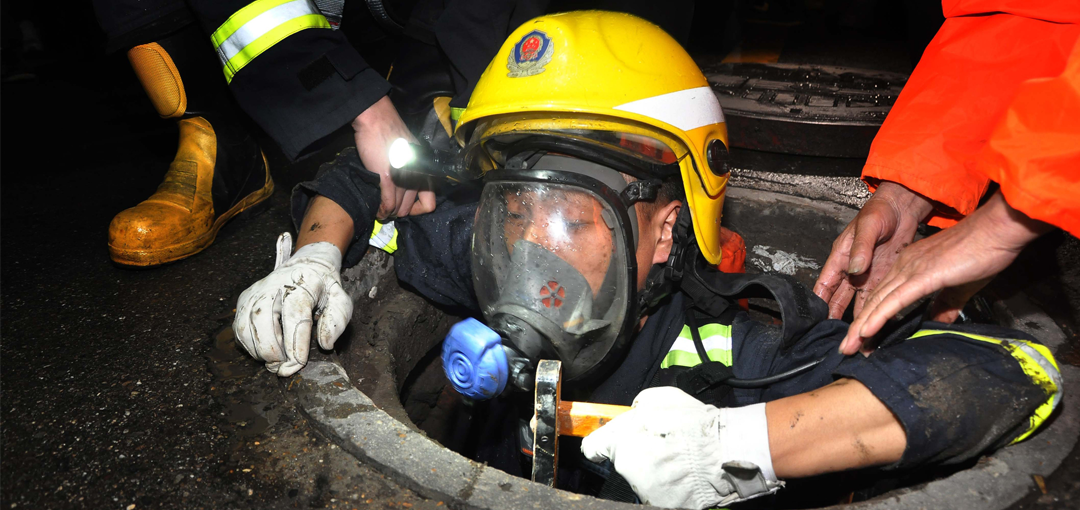Seven Atmospheric Hazards In Confined Spaces & How To Avoid Them
Seven Atmospheric Hazards In Confined Spaces & How To Avoid Them
November 8, 2023 |
Confined spaces, such as tanks, tunnels, and silos, are an integral part of various industries, from manufacturing to construction. While these spaces serve essential purposes, they can also be treacherous due to the presence of atmospheric hazards. Understanding and mitigating these atmospheric hazards in confined spaces is paramount to ensuring the safety of workers who must enter confined spaces as part of their job responsibilities.
Oxygen Deficiency
One of the most prevalent atmospheric hazards in confined spaces is oxygen deficiency. When the oxygen levels drop below the safe threshold of approximately 19.5%, it can lead to impaired cognitive function and, in severe cases, unconsciousness or death. To avoid this hazard, it’s crucial to test the oxygen levels before entry and continuously monitor them during work. Adequate ventilation is key to maintaining a safe oxygen concentration.
Oxygen Enrichment
On the opposite end of the spectrum, oxygen enrichment can also pose a significant threat. When oxygen levels exceed 23.5%, the risk of fire and explosion dramatically increases. This hazard often arises when oxygen cylinders or lines are present within a confined space. Workers must be trained to recognize this danger and take appropriate precautions, such as securing oxygen sources and using explosion-proof equipment.
Flammable Gases And Vapors
Confined spaces may contain flammable gases or vapors, which can lead to catastrophic explosions if ignited. To prevent this hazard, it’s essential to conduct thorough gas testing before entry and use intrinsically safe equipment in areas where flammable substances are present. Additionally, implementing a strict no-smoking policy and controlling potential ignition sources is crucial.
Toxic Gases
Toxic gases, such as hydrogen sulfide (H2S), carbon monoxide (CO), and ammonia (NH3), can accumulate in confined spaces and pose severe health risks. Exposure to these gases can lead to symptoms ranging from dizziness and nausea to respiratory failure or even death. To mitigate this hazard, employers must identify potential sources of toxic gases, provide proper ventilation, and equip workers with personal protective equipment, including respirators, when necessary.
Combustible Dust
In certain confined spaces, the accumulation of combustible dust particles can create an explosive atmosphere. These dust particles can ignite with a spark, causing violent explosions. Proper housekeeping practices, such as regular cleaning and dust control measures, are essential to prevent the buildup of combustible dust within confined spaces.
Confined Space Entry By Unauthorized Personnel
One often overlooked atmospheric hazard in confined spaces is the presence of unauthorized personnel. People who are not trained or equipped for confined space entry can inadvertently introduce hazards, disrupt ongoing work, or hinder rescue efforts in case of an emergency. To avoid this danger, establish strict access control measures and clearly mark confined spaces with warning signs.
Poorly Ventilated Spaces
Insufficient ventilation is a common atmospheric hazard in confined spaces. It can result in the accumulation of hazardous gases or vapors, as well as heat stress due to elevated temperatures. To address this hazard, ensure that adequate ventilation systems are in place and functioning correctly. Implementing an effective air exchange system helps maintain a safe atmosphere within the confined space.
Recognizing and mitigating atmospheric hazards in confined spaces is not just a recommended practice; it is an absolute necessity to ensure the safety and well-being of workers. These hazards, including oxygen deficiency, oxygen enrichment, flammable gases, toxic gases, combustible dust, unauthorized personnel, and poor ventilation, pose imminent threats that demand immediate attention and action.
Comprehensive safety training plays a pivotal role in this regard, equipping workers with the knowledge and skills needed to identify, evaluate, and respond to these atmospheric risks effectively. Proper equipment, meticulously maintained and regularly inspected, serves as the first line of defense against these dangers. From gas detectors to respirators, the right tools can mean the difference between a hazardous situation and a safe one.
Stringent safety protocols and procedures further reinforce the commitment to worker safety. These protocols are not merely guidelines; they are the backbone of a well-structured safety program. They dictate the steps to be taken before, during, and after confined space entry, leaving no room for ambiguity or shortcuts.
By embracing a proactive approach to safety, industries can significantly reduce the potential for accidents and injuries within confined spaces. It’s not enough to merely recognize the hazards; proactive measures are essential. This includes continuous monitoring, hazard assessment, well-maintained rescue equipment and meticulous planning before any confined space entry. The goal is not just to react to emergencies but to prevent them in the first place.
Creating a safer environment for those who work within confined spaces is a collective responsibility. It involves not only the efforts of confined space entry teams but also the commitment of management, supervisors, and all employees. Safety should be ingrained in the culture of an organization, with everyone fully aware of the risks and their role in mitigating them.
